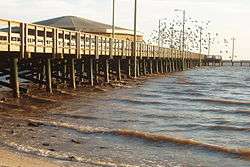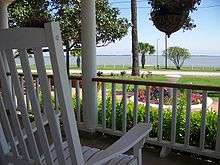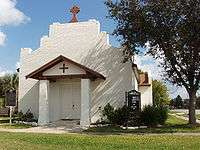Palacios, Texas
| Palacios, Texas | |
|---|---|
| City | |
 | |
| Nickname(s): City by the Sea | |
|
Location of Palacios, Texas | |
 | |
| Coordinates: 28°42′33″N 96°13′3″W / 28.70917°N 96.21750°WCoordinates: 28°42′33″N 96°13′3″W / 28.70917°N 96.21750°W | |
| Country | United States |
| State | Texas |
| County | Matagorda |
| Area | |
| • Total | 5.3 sq mi (13.7 km2) |
| • Land | 5.0 sq mi (13.1 km2) |
| • Water | 0.2 sq mi (0.6 km2) |
| Elevation | 13 ft (4 m) |
| Population (2000) | |
| • Total | 5,153 |
| • Density | 1,021.4/sq mi (394.4/km2) |
| Time zone | Central (CST) (UTC-6) |
| • Summer (DST) | CDT (UTC-5) |
| ZIP code | 77465 |
| Area code(s) | 361 |
| FIPS code | 48-54684[1] |
| GNIS feature ID | 1364710[2] |
Palacios (![]() i/pəˈlæʃəs/ pə-LASH-əs)[3] is a city in Matagorda County, Texas, United States. The population was 5,153 at the 2000 census.
i/pəˈlæʃəs/ pə-LASH-əs)[3] is a city in Matagorda County, Texas, United States. The population was 5,153 at the 2000 census.
Etymology
Popular local legend states that the area was named Tres Palacios ("Three Palaces") several centuries ago by shipwrecked Spanish sailors who claimed they saw a vision of three palaces on the bay. Historians believe it was more likely named for José Félix Trespalacios, an early Mexican governor of Texas. The town was originally called Trespalacios, but shortened its name due to a nearby post office already using the longer version.[4]
History
The native inhabitants of the region were the Karankawa people, whose initial contact with Europeans came in the 16th century when Spanish expeditions first traversed their territory. In 1685, the area was explored by René-Robert Cavelier, Sieur de La Salle, the leader of an ill-fated French settlement attempt whose flagship La Belle was wrecked in the bay the following year.[5] In the 1820s, English-speaking settlers arrived and came into frequent conflict with the Karankawa, who were eventually driven out of the area.[6]
The future site of Palacios was ranch land until 1901, when it was put up for sale by the estate of the former owner, Abel "Shanghai" Pierce. The land was purchased by a development company, surveyed into lots, and with the arrival of the Southern Pacific Railroad and the establishment of the Texas Baptist Encampment, it rapidly grew into a seaside resort town. It was first settled as a community in 1903.[7] City government was established in 1909, and by 1915, Palacios was home to more than 100 businesses, with a post office, library, weekly newspaper, numerous hotels, and churches, as well as a large entertainment pavilion built on a pier in the bay.[8]
In 1926, Camp Hulen (originally "Camp Palacios") was opened as a training center for the 36th Infantry of the Texas National Guard. The camp was leased by the War Department during World War II, when it was developed into a major antiaircraft training facility with a peak troop capacity of 14,560, and also served as a detention center for German prisoners of war.[9] The population of Palacios boomed during this period, and the city hosted visiting stars such as Rita Hayworth and Glenn Miller.[10]
After the war, Camp Hulen was closed and the local population declined. The town was hit by Hurricane Carla in 1961, causing major damage. Since then, the population has grown again, with the settlement of Vietnamese immigrants and other newcomers from all over the United States. In 1991, a pavilion was rebuilt on the waterfront, and in 1995 the La Belle shipwreck was rediscovered at the bottom of the bay, becoming the focus of a major archeological excavation. In 2009, the city marked its centennial with celebrations and other events.[11]
Geography

Palacios is located on the Gulf Coast at 28°42′33″N 96°13′3″W / 28.70917°N 96.21750°W (28.709153, -96.217588),[12] about halfway between Houston and Corpus Christi. It is connected to both cities by State Highway 35.
According to the United States Census Bureau, the city has a total area of 5.3 square miles (14 km2), of which, 5.0 square miles (13 km2) of it is land and 0.2 square miles (0.52 km2) of it (4.36%) is covered by water. It is located on the shores of Tres Palacios Bay, an arm of Matagorda Bay.
The Palacios area is known among birders for its wide diversity of bird life. Since 1997, as part of the 15-mile-diameter Matagorda County-Mad Island Marsh count circle of the National Audubon Society Christmas Bird Count, it has consistently reported more bird species than anywhere else in the United States. On December 19, 2005, a record 250 species were observed.[13]
Climate
Palacios experiences a humid subtropical climate. Average daytime high temperatures range from 62 °F (17 °C) in January to 90 °F (32 °C) in August. Average nighttime lows range from 44 °F (7 °C) in winter to 77 °F (25 °C) in summer.[14]
| Climate data for Palacios, Texas | |||||||||||||
|---|---|---|---|---|---|---|---|---|---|---|---|---|---|
| Month | Jan | Feb | Mar | Apr | May | Jun | Jul | Aug | Sep | Oct | Nov | Dec | Year |
| Average high °F (°C) | 61.9 (16.6) |
64.5 (18.1) |
70.3 (21.3) |
76.2 (24.6) |
82.5 (28.1) |
87.6 (30.9) |
89.7 (32.1) |
90.2 (32.3) |
87.2 (30.7) |
80.6 (27) |
71.5 (21.9) |
64.3 (17.9) |
77.2 (25.1) |
| Average low °F (°C) | 44.0 (6.7) |
47.0 (8.3) |
53.8 (12.1) |
60.7 (15.9) |
68.8 (20.4) |
74.6 (23.7) |
77.0 (25) |
75.8 (24.3) |
70.8 (21.6) |
62.0 (16.7) |
52.9 (11.6) |
45.9 (7.7) |
61.1 (16.2) |
| Average rainfall inches (mm) | 3.18 (80.8) |
2.45 (62.2) |
2.70 (68.6) |
2.80 (71.1) |
4.55 (115.6) |
4.31 (109.5) |
3.99 (101.3) |
3.36 (85.3) |
6.58 (167.1) |
5.01 (127.3) |
3.39 (86.1) |
3.08 (78.2) |
45.4 (1,153.1) |
| Source: Southern Regional Climate Center "Climate Normals for Palacios Municipal Airport" [15] | |||||||||||||
Demographics
| Historical population | |||
|---|---|---|---|
| Census | Pop. | %± | |
| 1870 | 35 | — | |
| 1910 | 1,389 | — | |
| 1920 | 1,335 | −3.9% | |
| 1930 | 1,318 | −1.3% | |
| 1940 | 2,288 | 73.6% | |
| 1950 | 2,799 | 22.3% | |
| 1960 | 3,676 | 31.3% | |
| 1970 | 3,642 | −0.9% | |
| 1980 | 4,667 | 28.1% | |
| 1990 | 4,418 | −5.3% | |
| 2000 | 5,153 | 16.6% | |
| 2010 | 4,718 | −8.4% | |
| Est. 2015 | 4,634 | [16] | −1.8% |

As of the census[1] of 2000, 5,153 people, 1,661 households, and 1,244 families resided in the city. The population density was 1,021.4 people per square mile (394.8/km²). There were 1,976 housing units at an average density of 391.7 per square mile (151.4/km²). The racial makeup of the city was 57.07% White, 4.74% African American, 0.68% Native American, 12.13% Asian, 22.36% from other races, and 3.03% from two or more races. Hispanics or Latinos of any race were 51.19% of the population.
Palacios has an unusually high percentage of Asian-Americans, as it is home to a large community of Vietnamese immigrants and their families.
Of the 1,661 households, 44.7% had children under the age of 18 living with them, 55.4% were married couples living together, 13.4% had a female householder with no husband present, and 25.1% were not families. About 22.0% of all households were made up of individuals, and 10.2% had someone living alone who was 65 years of age or older. The average household size was 3.08 and the average family size was 3.64.
In the city, the population was distributed as 35.4% under the age of 18, 9.1% from 18 to 24, 25.8% from 25 to 44, 18.6% from 45 to 64, and 11.1% who were 65 years of age or older. The median age was 30 years. For every 100 females, there were 100.9 males. For every 100 females age 18 and over, there were 95.7 males.
The median income for a household in the city was $27,623, and for a family was $35,518. Males had a median income of $27,483 versus $21,875 for females. The per capita income for the city was $13,107. About 19.8% of families and 24.2% of the population were below the poverty line, including 28.9% of those under age 18 and 14.3% of those age 65 or over.
Economy

Home to about 400 vessels, Palacios is the third-largest shrimping port on the Texas Gulf Coast, and has proclaimed itself to be the "Shrimp Capital of Texas".[18] The most common industries are educational services, agriculture/fishing, and construction.[19] The area has also long been a major center for energy production, and the county is positioning itself as an "energy cluster" for both conventional and alternative "green" power generation, with over $3 billion in new construction undergoing permitting as of 2011.[20] The local tourism industry is based on fishing, boating, birding and eco-tourism opportunities.[21]
Government
The City of Palacios has a council-manager government. As of 2011, the mayor is John C. Sardelich.[22]
Education
Palacios and neighboring areas are served by the Palacios Independent School District, with a vision statement of "Each child prepared with skills for a successful future". The school district includes Central Elementary, East Side Elementary, Palacios Junior High School, and Palacios High School (the junior high school and high school reside on the same campus grounds).
Transportation
The city is accessed by Texas State Highway 35 and served by the Palacios Municipal Airport. The Palacios Channel connects the Port of Palacios to the Gulf Intracoastal Waterway.[23] Greyhound Lines offers direct bus service from Palacios to Houston, Corpus Christi, and the Rio Grande Valley.[24]
Notable people
- Daniel E. Flores, Bishop of Brownsville, youngest Catholic bishop in the U.S. at the time of his episcopal appointment[25]
- William L. Jungers, anthropologist, best known for his work on the biomechanics of bipedal locomotion in hominids such as the 3.4 million-year-old Lucy[26][27]
- Priscilla Owen, controversial federal judge on the U.S. Court of Appeals for the Fifth Circuit, often mentioned as a potential supreme court nominee of George W. Bush[28]
Media
Palacios is home to the Palacios Beacon, a weekly newspaper established in 1907. It also serves nearby smaller communities such as Collegeport, Blessing, Midfield, Markham, El Maton, Carancahua, Deutschburg, and Cape Carancahua.[29]
Gallery
.jpg) A wedding at Palacios pavilion before a hurricane damaged the roof
A wedding at Palacios pavilion before a hurricane damaged the roof
See also
- René-Robert Cavelier, Sieur de La Salle
- French colonization of Texas
- La Belle (ship)
- Karankawa
- Palacios Municipal Airport
Further reading
- Braman, D. E. E. (1857). Braman's Information About Texas. Philadelphia: J. B. Lippincott & Co. pp. 44–47. Retrieved 2009-07-15.
- Elliott, M.D., J. R.; H. H. Loos, M.D. (January 1918). "Control Of Diphtheria In A Small Town". Texas State Journal of Medicine. XIII: 309–311. Retrieved 2009-07-15. Cite uses deprecated parameter
|coauthors=(help) - Writers' Program, Work Projects Administration, State of Texas (1940). Texas: A Guide To The Lone Star State (1943 edition). New York: Hastings House. pp. 44–47. Retrieved 2009-07-15.
Notes
- 1 2 "American FactFinder". United States Census Bureau. Retrieved 2008-01-31.
- ↑ "US Board on Geographic Names". United States Geological Survey. 2007-10-25. Retrieved 2008-01-31.
- ↑ http://www.rootsweb.ancestry.com/~txmatago/hmn_pa_pavilions.htm Palacios Pavilions
- ↑ Mary L. Griffin, "PALACIOS, TX," Handbook of Texas Online (http://www.tshaonline.org/handbook/online/articles/hfp01), accessed May 03, 2011. Published by the Texas State Historical Association.
- ↑ http://www.visitbaycity.org/history/index.html Historic Matagorda County
- ↑ http://www.tshaonline.org/handbook/online/articles/bmk05 Handbook of Texas Online "Karankawa Indians"
- ↑ Columbia-Lippincott Gazeteer p. 1413
- ↑ http://www.tshaonline.org/handbook/online/articles/hfp01 Handbook of Texas Online
- ↑ http://www.tshaonline.org/handbook/online/articles/qbc17 Handbook of Texas Online, "Camp Hulen"
- ↑ http://www.citybytheseamuseum.org/hulen.html Palacios Area Historical Association
- ↑ http://palacioschamber.com/touristinfo.html Palacios Chamber of Commerce "Our Heritage"
- ↑ "US Gazetteer files: 2010, 2000, and 1990". United States Census Bureau. 2011-02-12. Retrieved 2011-04-23.
- ↑ http://www.nature.org/wherewework/northamerica/states/texas/press/press2757.html Nature Conservancy in Texas
- ↑ http://www.srcc.lsu.edu/stations/index.php?action=metadata&network_station_id=416750 Southern Regional Climate Center
- ↑ "Southern Regional Climate Center". www.srcc.lsu.edu. 2011-05-08. Retrieved 2011-05-08.
- ↑ "Annual Estimates of the Resident Population for Incorporated Places: April 1, 2010 to July 1, 2015". Retrieved July 2, 2016.
- ↑ "Census of Population and Housing". Census.gov. Retrieved June 4, 2015.
- ↑ http://www.palacioschamber.com/tourist.htm Palacios Chamber of Commerce
- ↑ http://www.city-data.com/work/work-Palacios-Texas.html City Data
- ↑ http://www.mcedc.net/index.php Matagorda County EDC
- ↑ http://www.mcedc.net/about_us.php Matagorda County EDC "About Us"
- ↑ http://www.cityofpalacios.org City of Palacios
- ↑ http://www.portofpalacios.com Port of Palacios
- ↑ http://www.greyhound.com Greyhound Lines
- ↑ Palmo, Rocco (2006-11-29). "The Bishop Is Sent, Breathing Forth Hope". Whispers in the Loggia.
- ↑ http://commcgi.cc.stonybrook.edu/am2/publish/Medical_Center_Health_Care_4/Dr_William_Jungers_Anthropologist_and_Renowned_Res_1270.shtml Stony Brook University
- ↑ http://www.anat.stonybrook.edu/IDPAS/faculty/JungersCV.pdf Stony Brook University
- ↑ See Speech by Texas Senator Kay Bailey Hutchison via Archive.org (2005-05-18).
- ↑ http://www.palaciosbeacon.com/home/aboutus.htm Palacios Beacon "About Us"
External links
| Wikimedia Commons has media related to Palacios, Texas. |
| Wikivoyage has a travel guide for Palacios. |
- City of Palacios
- Palacios Beacon
- Palacios Chamber of Commerce
- Palacios Area Historical Society and City By The Sea Museum
- Palacios, Handbook of Texas Online
- Palacios Independent School District
